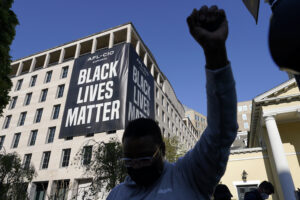How Newsrooms Fail to Reflect America, and Why It Matters
Too often, there's only one person among the reporters and editors to speak up for diversity. 1
2
1
2

Detail from an ad featuring MSNBC’s presidential “embeds”—young reporters traveling with the 2016 candidates. (MSNBC)
This ad in The Washington Post jumped out at me. In one tight photograph, it quickly telegraphs what’s wrong with the news media today and why the audience isn’t growing.
Yes, it’s great to see young women flourishing on the campaign trail. Yes, the casual chic may appeal to some millennials. But given that our country is on its way to the long-dominant white majority becoming the minority, this photo doesn’t reflect society. If I were an African-American or Hispanic — and I’m not — I would not see myself in this photo. (OK maybe if you look really closely you might discern that Kristen Welker, second from right, is biracial. Her mother is black and her father white.)
It’s photos like this and census data about the news industry that prompted the National Association of Black Journalists and National Association of Hispanic Journalists to make continued lack of diversity in newsrooms a topic at their recent joint convention in Washington.
Currently, minorities make up 37.02 percent of the US population, according to the US Census Bureau. Precious few newsrooms match this.
Of the more than 600 newspapers participating in the most recent American Society of Newspaper Editors Diversity survey, just 19 had an equal or greater percentage of minorities than the population at large. For more than a decade, the representation of journalists of color in daily newspaper newsrooms overall has hovered between 12 and 14 percent, according to the ASNE, which began its newspaper employment census in 1978. (That year, only 3.95 percent of full-time journalists were minorities.) You can see the latestfull survey results here.
“Minority representation in the newsroom and digital properties are still shockingly low,” said Donna Byrd, publisher of TheRoot.com, which has an African-American-centric focus, at the convention. “There’s still quite a lot of room for opportunity and growth. There’s progress being made but there’s a long way to go.” She added that “masthead” management still tends to hire voices they are used to seeing.
There is good news when it comes to television, according to the Radio-Television Digital News Association. Its survey with Hofstra University found the minority workforce in local TV news rose to 23.1 percent. Percentages are highest in the top 25 markets. TV tends to better reflect the population because it’s a visual medium and viewers can plainly see the ethnicity and gender of a reporter or anchor.
The minority breakdown at non-Spanish language TV stations, according to the survey, is 11.4 percent African-American, 6.7 percent Hispanic, 2.7 percent Asian American and 0.4 percent Native American.
The numbers were doing better until 2008, when the recession started decimating newsrooms, and minorities were disproportionately affected,” said Eric Deggans, author of Race Baiter: How the Media Wields Dangerous Words to Divide a Nation. “Newsrooms have a set of priorities. Diversity is ninth or tenth and when the downturn came, it slid off the table.” The 2008 downturn largely hurt minorities because “last hired” is often “first fired.”
When we asked MSNBC about the lack of diversity in its “road warriors” ad, the network responded by providing a list of its on-air talent of color, a list of eight that includes Welker and José Diaz-Balart, although he has left his regular gig on the cable channel’s air for a seat at the NBC Nightly News anchor desk (weekend edition). A promised breakdown of MSNBC’s staff demographics didn’t arrive by deadline.
Census projections indicate that minorities will become a majority in the US by 2044, which makes it imperative to have more diverse voices and perspective in traditional and digital media.
Why does it matter?
For starters, diversity is good for business. If the audience doesn’t see itself reflected in news stories, then minorities often think their interests are being ignored, misinterpreted, distorted or undervalued. The downside is the audience goes elsewhere at a time when growing the audience is critical to a news operation’s sustainability.
If I see a panel on Sunday morning political chat shows with mostly white men, I’ll turn the channel. Producers of Sunday shows are slowly filling chairs with more women and people of color, but they still tilt largely to white males.
Kevin Riley, editor of The Atlanta Journal-Constitution, told Nieman Reports that a diverse staff results in better journalism for readers. “That’s sort of the business payoff,” he said. “This is beyond just a nice idea, beyond the right thing to do, and beyond recognizing our troubled history around race. It’s a business imperative.”
If the minority population is growing steadily, then common sense would say news organizations should be doing everything they can to attract minority audiences and better explain the complex issues America faces.
Your support matters…Independent journalism is under threat and overshadowed by heavily funded mainstream media.
You can help level the playing field. Become a member.
Your tax-deductible contribution keeps us digging beneath the headlines to give you thought-provoking, investigative reporting and analysis that unearths what's really happening- without compromise.
Give today to support our courageous, independent journalists.






You need to be a supporter to comment.
There are currently no responses to this article.
Be the first to respond.